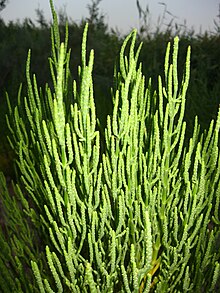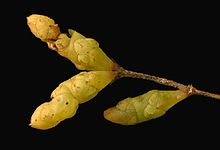Salicornia
| Salicornia | |
|---|---|

| |
| Salicornia europaea | |
| Scientific classification | |
| Kingdom: | Plantae |
| Clade: | Tracheophytes |
| Clade: | Angiosperms |
| Clade: | Eudicots |
| Order: | Caryophyllales |
| Family: | Amaranthaceae |
| Subfamily: | Salicornioideae |
| Genus: | Salicornia L. |
| Species | |
|
See text | |
Salicornia is a
Description

The Salicornia species are small annual herbs. They grow prostrate to erect, their simple or branched stems are succulent, hairless, and appear to be jointed. The opposite
All stems terminate in spike-like apparently jointed
The perianth is persistent in fruit. The fruit wall (pericarp) is membranous. The vertical seed is ellipsoid, with yellowish brown, membranous, hairy seed coat. The seed contains no
Like most members of the subfamily Salicornioideae, Salicornia species use the C3 carbon fixation pathway to take in carbon dioxide from the surrounding atmosphere.[4]
Taxonomy

The genus Salicornia was first described in 1753 by Carl Linnaeus.[5] Salicornia europaea was selected as the type species.[6]
The genus probably originated during the
The taxonomic classification of this genus is extremely difficult (with one paper calling it a "taxonomic nightmare").[8] The determination of species seems almost impossible for non-specialists. The reasons for these difficulties are the reduced habit with weak morphological differentiation and high phenotypic variability. As the succulent plants lose their characteristics while drying, herbarium specimens often cannot be determined with certainty and are less suited for taxonomic studies.[8]
Species

As of April 2022[update], Plants of the World Online accepted the following species:
- Salicornia alpini Lag.
- Salicornia ambigua Michx.
- Salicornia andina Phil.
- Salicornia bigelovii Torr.
- Salicornia blackiana Ulbr.
- Salicornia brachiata Roxb.
- Salicornia capensis (Moss) Piirainen & G.Kadereit
- Salicornia crassispica G.L.Chu
- Salicornia cuscoensis Gutte & G.K.Müll. ex Freitag, M.Á.Alonso & M.B.Crespo
- Salicornia decumbens (Toelken) Piirainen & G.Kadereit
- Salicornia decussata (S.Steffen, Mucina & G.Kadereit) Piirainen & G.Kadereit
- Salicornia disarticulata Moss
- Salicornia dunensis (Moss ex Adamson) Piirainen & G.Kadereit
- Salicornia erectispica G.L.Chu
- Salicornia europaea L.
- Salicornia fruticosa (L.) L.
- Salicornia globosa (Paul G.Wilson) Piirainen & G.Kadereit
- Salicornia helmutii Piirainen & G.Kadereit
- Salicornia hispanica (Fuente, Rufo & Sánchez Mata) Piirainen & G.Kadereit
- Salicornia lagascae (Fuente, Rufo & Sánchez Mata) Piirainen & G.Kadereit
- Salicornia littorea (Moss) Piirainen & G.Kadereit
- Salicornia magellanica Phil.
- Salicornia maritima S.L.Wolff & Jefferies
- Salicornia × marshallii (Lambinon & Vanderp.) Stace
- Salicornia meyeriana Moss
- Salicornia mossambicensis (Brenan) Piirainen & G.Kadereit
- Salicornia mossiana (Toelken) Piirainen & G.Kadereit
- Salicornia natalensis Bunge ex Ung.-Sternb.
- Salicornia neei Lag.
- Salicornia nitens P.W.Ball & Tutin
- Salicornia obclavata (Yaprak) Piirainen & G.Kadereit
- Salicornia obscura P.W.Ball & Tutin
- Salicornia pachystachya Bunge ex Ung.-Sternb.
- Salicornia pacifica Standl.
- Salicornia perennans Willd.
- Salicornia perennis Mill.
- Salicornia perrieri A.Chev.
- Salicornia persica Akhani
- Salicornia perspolitana Akhani
- Salicornia praecox A.Chev.
- Salicornia procumbens Sm.
- Salicornia pruinosa (Fuente, Rufo & Sánchez Mata) Piirainen & G.Kadereit
- Salicornia pulvinata R.E.Fr.
- Salicornia quinqueflora Bunge ex Ung.-Sternb.
- Salicornia rubra A.Nelson
- Salicornia senegalensis A.Chev.
- Salicornia sinus-persica Akhani
- Salicornia tegetaria (S.Steffen, Mucina & G.Kadereit) Piirainen & G.Kadereit
- Salicornia terminalis (Toelken) Piirainen & G.Kadereit
- Salicornia uniflora Toelken
- Salicornia utahensis Tidestr.
- Salicornia virginica L.
- Salicornia xerophila (Toelken) Piirainen & G.Kadereit
Distribution and habitat

The species of Salicornia are widely distributed over the Northern Hemisphere and in southern Africa, ranging from the subtropics to subarctic regions. There is one species present in New Zealand.[10]
They grow in coastal salt marshes and in inland salty habitats like shores of salt lakes.[8] Salicornia species are halophytes and can generally tolerate immersion in salt water (hygrohalophytes).
Ecology
Salicornia species are used as food plants by the larvae of some Lepidoptera species, including the Coleophora case-bearers C. atriplicis and C. salicorniae; the latter feeds exclusively on Salicornia spp.
Uses
Culinary

S. europaea is edible, either cooked or raw,
In Hawaii, where it is known as 'sea asparagus', it is often blanched and used as a topping for salads or accompaniment for fish.[14][15]
In addition to S. europaea, the seeds of
Umari keerai (S. brachiata) is cooked and eaten or pickled. It is also used as fodder for cattle, sheep and goats.[16] In Kalpitiya, Sri Lanka, it is used to feed donkeys.
On the east coast of Canada, the plant is known as 'samphire greens' and is a local delicacy. In southeast Alaska, it is known as beach asparagus. In Nova Scotia, Canada, they are known as crow's foot greens. In British Columbia, they are known as sea asparagus.[17] In the United States, they are known as 'sea beans' when used for culinary purposes. Other names include sea green bean, sea pickle, and marsh samphire.[18]
In India, researchers at the Central Salt and Marine Chemicals Research Institute developed a process to yield culinary salt from S. brachiata. The resulting product is known as vegetable salt and sold under the brand name Saloni.[19]
Dehydrated, pulverized Salicornia is sold under the brand name "Green Salt" as a salt substitute claimed to be as salty in taste as table salt, but with less sodium.[20][21]
Pharmacological research
In South Korea, Phyto Corporation has developed a technology of extracting low-sodium salt from S. europaea, a salt-accumulating plant. The company claims that the naturally derived plant salt is effective in treating
Environmental uses
Industrial use
Historical

The ashes of
Umari keerai is used as raw material in paper and board factories.[16]
Contemporary
Because S. bigelovii can be grown using saltwater and its seeds contain high levels of unsaturated
Experimental fields of Salicornia have been planted in Ras al-Zawr (
Stems and roots of S. brachiata plants have a high cellulose content (ca. 30 wt. %), whereas tender stem tips exhibit a low cellulose content (9.2 wt. %).[34] S. brachiata revealed the dominance of rhamnose, arabinose, mannose, galactose, and glucose, with meager presence of ribose and xylose in their structural polysaccharide.[35]
See also
References
- ^ Salicornia Archived 2018-09-13 at the Wayback Machine, Integrated Taxonomic Information System, serial number 20646.
- ISBN 978-1-5272-2630-2.
- ^ ISBN 978-0-19-517389-5. Online version retrieved August 10, 2016.
- S2CID 83564261.
- ^ Carl Linnaeus (1753). Species Plantarum, Tomus I: 3. First description of Salicornia, scanned at BHL Archived 2014-05-21 at the Wayback Machine
- ^ "Salicornia". Tropicos. Missouri Botanical Garden. Retrieved 2016-08-11.
- ^ doi:10.12705/661.6.
- ^ JSTOR 25065909.
- hdl:2268/153011. Archivedfrom the original on 2020-07-14. Retrieved 2020-09-16.
- ^ "Flora of New Zealand | Taxon Profile | Salicornia quinqueflora". www.nzflora.info. Archived from the original on 2021-02-13. Retrieved 2021-02-19.
- ^ a b "Salicornia" Archived 2007-09-27 at the Wayback Machine, page of the Plants for a Future website Archived 2019-10-18 at the Wayback Machine. Retrieved July 14, 2007.
- OCLC 965922681.
- ISBN 978-0-684-80001-1.
- ^ "Tasting Hawai'i With Moloka'i Chef James Temple: The Other Asparagus... Sea Asparagus". tastinghawaii.com. November 10, 2013. Archived from the original on September 28, 2018. Retrieved September 28, 2018.
- ^ "Eating Local, Hawaiian-Style: Sea Asparagus and Ahi Poke Omaraisu". spiceboxtravels.com. April 3, 2015. Archived from the original on September 28, 2018. Retrieved September 28, 2018.
- ^ a b Salicornia, oil-yielding plant for coastal belts, The Hindu
- ^ "Sea Asparagus". Archived from the original on 2016-01-17. Retrieved 2016-05-05.
- ^ Cook's Thesaurus: Sea Vegetables Archived 2013-05-01 at the Wayback Machine, retrieved 2012-10-08.
- ^ "Indian scientists produce salt from vegetable". The Economic Times (India). 18 May 2003. Archived from the original on 2015-06-27. Retrieved 2015-06-26.
- ^ Florence Fabricant, "To Sprinkle: Add Some Green To Your Salt Lineup", New York Times, August 11, 2021, p. D3; online version "Add Green to Your Salt Lineup" August 9, 2021
- ^ Green Salt web site, [1] Archived 2021-08-30 at the Wayback Machine
- PMID 28608557.
- PMID 27455235.
- PMID 28778046.
- PMID 29521146.
- ISBN 9781429219617.
- PMID 15012198.
- ^ (PDF) from the original on 2015-09-06. Retrieved 2008-11-17.
- ^ a b Clark, Arthur (November–December 1994). "Samphire: From Sea to Shining Seed" (PDF). Saudi Aramco World. Saudi Aramco. Archived from the original (PDF) on 2011-07-26. Retrieved 2008-11-17.
- ^ Alsaeedi, Abdullah H. (2003). "Di Pattern of Salicornia Vegetative Growth in Relation to Fertilization" (PDF). Journal of King Faisal University. 4 (1). Al-Hassa: King Faisal University: 105–18. Retrieved 2008-11-17.
adequate fertilization increases significantly the relative growth rate especially during the 'rapid' phase of the vegetative stage
[dead link] - ^ "USIJI Uniform Reporting Document" (PDF). United States Initiative on Joint Implementation. c. 1997. Archived from the original (PDF) on 2011-07-26. Retrieved 2008-11-17.
Project Salicornia: Halophyte Cultivation in Sonora
- ^ Ryan C. Christiansen (2008-07-31). "Sea asparagus can be oilseed feedstock for biodiesel". Biomass Magazine. Archived from the original on 2009-07-20. Retrieved 2008-11-17.
- ^ Dickerson, Marla (2008-07-10). "Letting the sea cultivate the land". Los Angeles Times. Archived from the original on 2011-08-11. Retrieved 17 November 2008.
- S2CID 12588647.
- PMID 25129748.
External links
 Media related to Salicornia at Wikimedia Commons
Media related to Salicornia at Wikimedia Commons Data related to Salicornia at Wikispecies
Data related to Salicornia at Wikispecies- BBC Good Food Channel - recipes for both marsh rock samphire.
- Biff Vernon discusses the common confusion between marsh samphire and rock samphire, and reproduces a poem on the subject by William Logan.
- Robert Freedman
- Seawaterfoundation running a seawater farm in Eritrea with Salicornia to produce oil, food and store carbon dioxide
